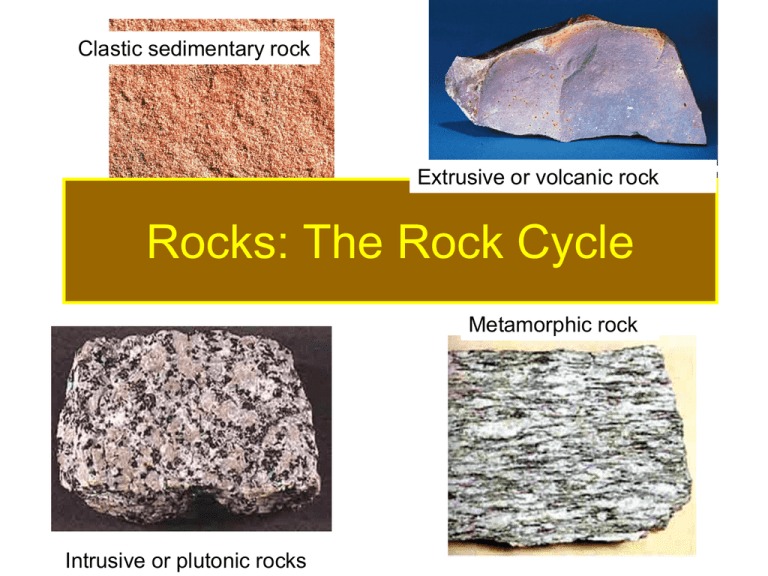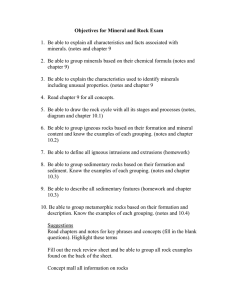Rocks: The Rock Cycle Clastic sedimentary rock Extrusive or volcanic rock Metamorphic rock
advertisement

Clastic sedimentary rock Extrusive or volcanic rock Rocks: The Rock Cycle Metamorphic rock Intrusive or plutonic rocks Review: rock forming minerals • Silicate minerals are formed when a magma or lava cools to a solid • The solid is now an igneous rock Igneous intrusive or plutonic rock: minerals are visible to the naked eye Igneous extrusive or volcanic rock: basalt with olivine crystals; the basalt is black because the mineral crystals are very small Volcanic Plutonic Igneous rocks are formed how? Extrusive or volcanic Intrusive or plutonic Igneous rocks are formed from magma crystallization. Igneous rocks are formed where? Mid-oceanic ridges: new oceanic crust forms Where there is a concentration of heat Volcanic arcs: where oceanic crust subducts under the opposing crust Crystal or mineral size is determined by cooling rate Intrusive or plutonic rocks are cooled within the Earth’s crust: cooled slowly, larger crystals • Extrusive or volcanic rocks are cooled on the Earth’s crust: cooled quickly, crystals smaller Intrusive or plutonic Extrusive or volcanic Minerals are the building block of rocks Quartz Biotitie Feldspar crystal Hornblende Sketch a diagram of the rock and identify the minerals. Igneous Textures Large crystals “floating” in a fine-grained matrix Classifying igneous rocks • Texture and mineral composition • All terms listed on this image are important How different compositions are produced The order of crystallization from basic to felsic composition based on temperature changes. How different compositions are produced •The mafic minerals crystallize first. •This makes the melt more felsic •A method of changing the magma composition Sedimentary rocks Limestone Chemical Biochemical Clastic Diatomite Sandstone and mudstone Chemical Evaporate: halite and gypsum • Water evaporates leaving the dissolved salts • Calcium carbonate is the first to form • Gypsum is the second • Halite is the third • Other salts crystallize Halite: salt-NaCl Gypsum: CaSO4·2H2O • Sheet rock • Fertilizer Precipitates: limestone • Precipitate from sea water • In the same order as minerals form from evaporation • CaCO3 is the first and most abundant • Limestone Precipitation Warm sea water becomes supersaturated in calcium carbonate. The calcium carbonate precipitates out of solution to form a mud. The mud hardens and becomes limestone. Limestone: biochemical sedimentary rock Formed in warm, shallow oceans Sea water becomes oversaturated with calcium carbonate. The calcium carbonate precipitates out of solution behind the reef. Limestone is used for Portland cement Diatomite: biochemical sedimentary rock • Diatoms (single celled plants) and mud • Compacted and cemented to become rock The Monterey Formation New Zealand diatomite Diatomite: biochemical sedimentary rock • The photic zone is the top 600 feet of the ocean • This is where plankton live including diatoms Diatomite: biochemical sedimentary rock Kitty Litter Petroleum: California Planters mix: soluble silica; nutrient Dynamite Abrasive Clastic Sedimentary Rocks Clastic: pieces from preexisting rock; the type of rock in exercise Chemical or biochemical: we will learn about this later Clastic Sedimentary Rocks Fragments of preexisting rocks Clastic sediments are formed from pre-existing rocks. • Rocks are weathered (broken down) Clastic sedimentary rocks • Rocks are broken down or weathered Liken extracts minerals from rock Water extracts elements and moves sediment Gravity pulls broken rock down slope Clastic sediments are formed from pre-existing rocks. • Eroded or moved Wind Water Glaciers Clastic sediments are formed from pre-existing rocks. • Deposited Water tends to sort sediment by size Glaciers move many sizes of sediment Stream carrying sediment into a lake Sediments are deposited in many environments Marine: beach, offshore, deep ocean Non-marine: glaciers, lakes, streams, alluvial fans Lithification • The sediments are buried, compacted and cemented to become a rock. Sandstone What do these sedimentary rocks have in common? Limestone Diatomite Sandstone and mudstone Sedimentary rocks are deposited in layers. Sand and Gravel • Sand and gravel is mined from young river deposits • The sediment has not been buried or lithified. • 1.16 billion $/yr (CA) Placer Deposits • Gold veins are exposed to the Earth’s surface: weathered; eroded; and deposited as sediment • The first gold discovered in California was a placer deposit Metamorphic Rocks A rock changed by heat and pressure Metamorphic Rocks • When rocks are subjected to heat and pressure, the atoms may move around • New minerals may form • Foliation or preferential lining up of minerals, may form Metamorphic Rocks • Quartzite: recrystallized quartz-rich sandstone Metamorphic Rocks • Foliation or preferential lining up of minerals, may form Metamorphism Metamorphic rocks Slate: from mudstone Copper, zinc and gold are concentrated in the bands. Marble: from limestone Gneiss: from granite Metamorphic rocks • Changed with heat and pressure • Where? – Magma intrudes colder rocks: colder rocks are “baked” at the contact – Hot fluids from magma: inject hot fluid and “leftovers” from a magma chamber Paired Metamorphic Belts Subduction zone: high pressure and low temperature metamorphic rocks Intrusive or plutonic rocks: contact metamorphism; high temperature, lower pressure Metamorphic minerals are used to determine pressure and temperatures Geobarometers • Metamorphic minerals form at distinct temperatures and pressures • Therefore, geologists can determine at what pressures and temperatures rocks were formed Geothermometers The central Sierra Nevada were emplaced at about 8-10 miles below the Earth’s surface Paired Metamorphic belts Regional Contact Geobarameters: determine pressure The Rock Cycle • Explains how all rocks are recycled through different processes • Important point: a rock’s name is determined by how it is formed Volcanic rock formation? Intrusive or plutonic rock formation? Clastic sedimentary rock formation? Metamorphic rock formation? Using the box of rocks provided, write the steps that would change one rock to another rock. What to understand: • The process each rock must pass through to become another rock type • Classification of igneous, sedimentary, and metamorphic rocks • Where heat is concentrated to melt or metamorphose rocks • Metamorphic belts: where – Geobarameters and geothermometers




